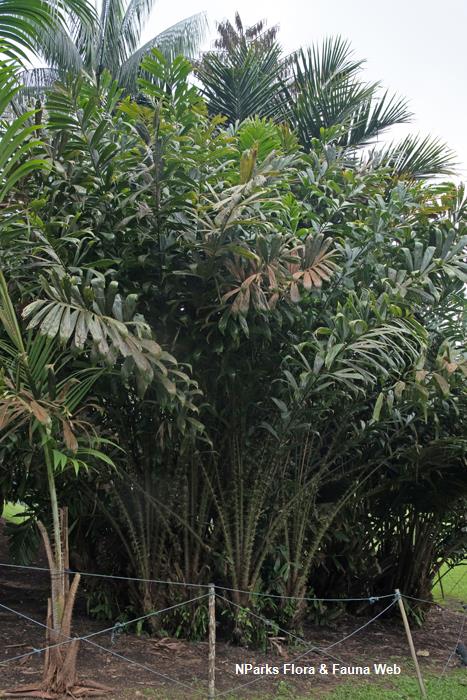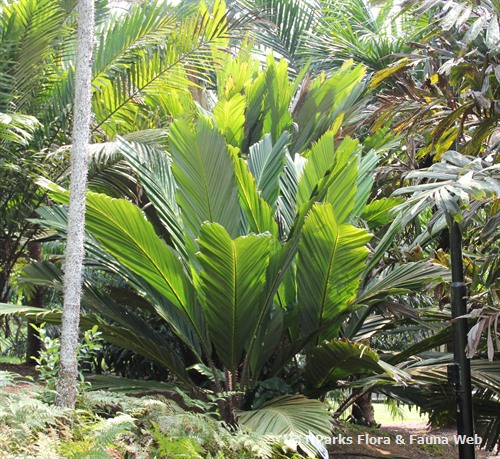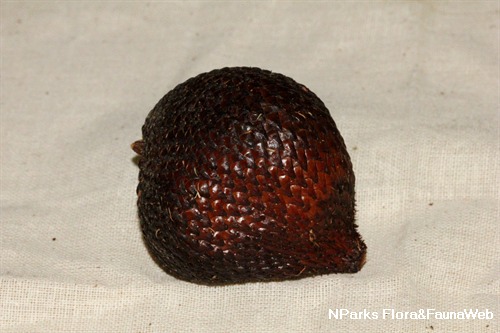_lowres.jpg)
Back
Salacca wallichiana Mart.
| Family Name: | Arecaceae (Palmae) |
| Synonyms: | Calamus zalacca Roxb., Salacca edulis Whitmore non Reinw., Zalacca edulis Wall. non Reinw., Zalacca rumphii Blume., Zalacca beccarii Hook.f., Zalacca macrostachya Griff. |
| Common Name: | Rakam, Rakum, Kumbar, Salak Kumbar, Salak Rengam |
Found in swampy areas, Salacca wallichiana is a clustering spiny palm with huge leaves that can reach up to 7 m long. It produces sweet tasting fruits that are densely covered with reddish brown spiny scales.
Name
Classifications and Characteristics
| Plant Division | Angiosperms (Flowering Seed Plants) |
|---|---|
| Plant Growth Form | Palm |
| Lifespan (in Singapore) | Perennial |
| Mode of Nutrition | Autotrophic |
| Maximum Height | 12 m |
Biogeography
| Native Distribution | Myanmar, Vietnam, Peninsular Malaysia, Sumatra |
|---|---|
| Native Habitat | Terrestrial |
| Preferred Climate Zone | Tropical |
| Local Conservation Status | Non-native |
Description and Ethnobotany
| Growth Form | It is a clustering dioecious palm, up to 12 m tall with stem up to 0.2 m wide and presence of many adventitious roots. |
|---|---|
| Foliage | There are 12 – 18 leaves on each stem. The leaves are about 5 – 7 m long, pinnate with 40 – 60 leaflets on each side, and cluster in groups of 2 – 5. The leaflets are sigmoid shaped (70 – 100 cm long and 8 cm wide) and point in different directions. The sheath and petiole are heavily armed with black spines in whorls of up to 8 cm long. |
| Flowers | Each stem bears 2 – 3 inflorescence stalks. They emerge through the groove on the leaf base. The male inflorescence reaches up to 2 – 3 m long, and has 10 first order branches. The female inflorescence reaches up to 0.7 m long and has fewer branches compared to the male inflorescence. Both branches are reddish and spike-like (up to 10 cm long). Flowers are 3-lobed with non-overlapping petals. Male flower has 6 stamens and occurs in a pair (dyads), while the female flower occurs in solitary or in a pair with a sterile male flower. |
| Fruit | Fruit is obovate shaped (7 – 8 cm long and 4 – 5 cm wide) with apical stigmatic remains. The fruit is densely covered with reddish brown spiny scales and has 1 – 3 seeds within. The seeds are covered with edible and sweet tasting flesh (sarcotesta). |
| Habitat | It is found in swampy areas. |
| Associated Fauna | It is pollinated mainly by insects. |
| Taxonomy | The species is quite variable. There is one form with complete absence of spines on the leaf sheath, petiole and rachis, and another form that is unarmed. |
| Etymology | The species epithet honours Nathaniel Wallich, 19th century Danish botanist and surgeon who had described many new species of plant and made a large herbarium collection. |
| Ethnobotanical Uses | Edible Plant Parts : Edible Fruits Food (Fruit or Vegetable): Ripe fruits are eaten raw, taste sweet and said to be rich in vitamin B. Others: In rural areas, the palm is reportedly used for construction, roof thatching and making of cork. |
Landscaping Features
| Usage Hazard - Cons | Spines/Thorns - Leaf, Spines/Thorns - Stem/Branch, Spines/Thorns - Trunk |
|---|
Plant Care and Propagation
| Light Preference | Full Sun |
|---|---|
| Water Preference | Moderate Water |
| Plant Growth Rate | Moderate |
| Rootzone Tolerance | Waterlogged Soils |
Foliar
| Mature Foliage Colour(s) | Green |
|---|---|
| Foliar Shape(s) | Palm Fronds (Pinnate / Feather) |
Non - Foliar and Storage
| Trunk Type (Palm) | Clustering Habit |
|---|
References
| References | Barfod, A.S. & Dransfield, J. (2013). Arecaceae. In Santisuk, T. & Larsen, K. (eds) Flora of Thailand, vol 11, part 3, pp. 323-498. Bangkok: The Forest Herbarium, National Park, Wildlife and Plant Conservation Department. Polprasid, P. (1992) Salacca wallichiana In: Verheij, E.W.M., Coronel, R.E. (eds) Plant Resources of South-East Asia Volume 2, Edible Fruits and Nuts. pp. 278-281. Indonesia: Prosea Foundation. |
|---|
Image Repository
Others
| Master ID | 30825 |
|---|---|
| Species ID | 5180 |
| Flora Disclaimer | The information in this website has been compiled from reliable sources, such as reference works on medicinal plants. It is not a substitute for medical advice or treatment and NParks does not purport to provide any medical advice. Readers should always consult his/her physician before using or consuming a plant for medicinal purposes. |


_lowres.jpg)
_lowres.jpg)
_lowres.jpg)
_lowres.jpg)
_lowres.jpg)


